Noble sword in the struggle for the Old Russian inheritance
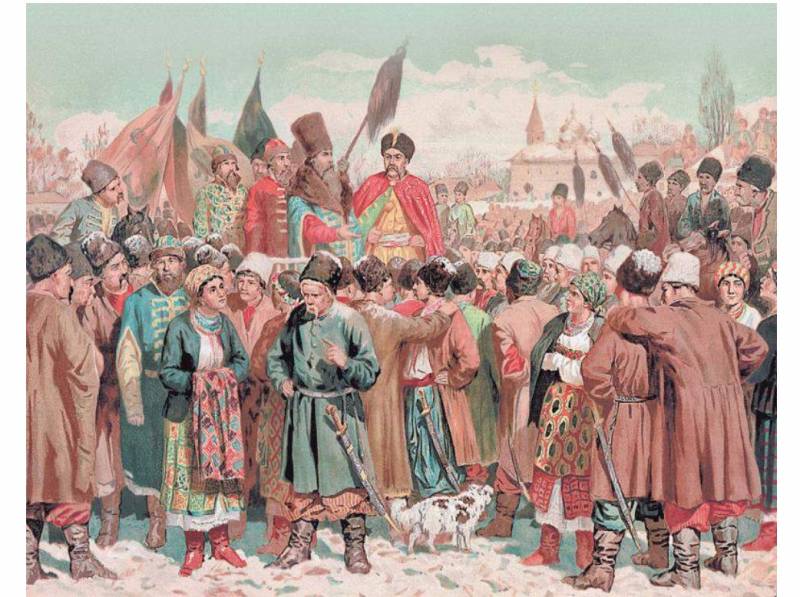
Pereyaslav Council. 1654 Hood. Kivshenko A.D. XNUMXth century
This article will focus on the influence of external factors on the evolution of the Russian state in the XNUMXth century. The article was written as part of a series devoted to the evolution and development of the Russian state, the development of its management system and social relations.
The fate of Russian lands in the west and south of Eastern Europe
As I wrote in an article on VO “How Rus' became Lithuanian,” until a certain period, the development of ancient Russian lands that fell under the rule of the Grand Duchy of Lithuania and even Poland occurred in the same way as in the northeast of Rus'. Not only did the external threat bleed these lands and slow down their development, this was also influenced by the fact that most of the lands came under the sovereignty of the Grand Duke of Lithuania. Princes of tribes that lagged behind in their development at the time of the establishment of their power over the ancient Russian lands of the south and west of Ancient Rus'.
The external threat from the Order forced the great Lithuanian princes to unite with their more socially and economically developed neighbor - Poland. This process was not easy, leading to hostilities between supporters and opponents of the unification; it took a long period and ended with the creation of the Polish-Lithuanian Commonwealth in 1569 (from the Latin republic - “Common Cause”).
The model of the Polish social structure attracted the nobility of the GDL, it was the "charm" of a more comfortable material life. Although the Lithuanian-Russian lords believed that we ourselves were "with a mustache." Poland, unlike the Grand Duchy of Lithuania, was already a feudal country, and therefore a country standing at a higher stage of development.
It was at this time in the XNUMXth century that the thorny path of “organic” development of the Russian western and southern lands was interrupted. The imposition of feudal orders began “from above”, from the foreign, and also non-religious, dominant Polish nobility. With the arrival of the Polish feudal lords, the colonization of undeveloped and empty steppe lands began, which received the name, along with the already developed Russian lands of the Grand Duchy of Lithuania, Ukraine. Both Lithuanian and Russian nobility joined this movement.
The wild field, very rough, began just south of Kyiv. The Polish knighthood was, of course, more educated than the feudal lords living to the east. The best of them tried to manage estates in a “scientific” way, as described in A. Gostomsky’s book “Economy” (1588). That did not stop the “knights” from leading a semi-robber lifestyle, carrying out the “colonization” of Russian lands in the west of Eastern Europe using the most brutal methods. The nobleman disposed of the life and soul of his “man of the fatherland” (serf) as he wanted.
On top of that, since the XNUMXth century, with the development of bourgeois relations in Europe and the formation of different markets, the value of commercial grain has increased. This also adds marketable value to the land. If previously land was a source of support for the feudal owner, now it is also becoming a source of income. The gentry, like any military class at the stage of developed feudalism, now saw more benefits not in the war, but in the exploitation of the peasants.
The situation was aggravated by the gentry's transfer of their estates for rent and management to tenants who extort profits in any way, finding all sorts of ways to “extract” money from peasants and townspeople, including the seizure and “exploitation” of Orthodox churches. Due to the fact that there were a large number of Jews among the tenants, this was considered by Orthodox peasants and townspeople as an attack on faith.
After the Brest Church Union of 1596, which decided to unite Catholics and Orthodox Christians, pressure on the latter also intensified from the Uniates. The struggle went in different directions: Catholics put pressure on both the Orthodox and the Uniates, and the Uniates put pressure on the Orthodox.
The Poles were also followed by the Russian nobility of these lands, changing the “cotton faith” after receiving privileges. Thus, the prince and all-powerful magnate Jerimiy Vishnevetsky (1612–1651), an irreconcilable fighter against the Cossacks and the nephew of the Kyiv Orthodox Metropolitan Peter Mogila, converted to the Catholic faith at a conscious age. No wonder Uniate Archbishop A. Selyava wrote:
Because for these lands the feudal model was inseparable from Catholicism and Polonization. No wonder the French engineer Beauplan wrote that the gentry lived in paradise, while the peasants were in purgatory.
The factor of faith arises with particular urgency throughout Europe, but if to the west the struggle takes place in countries standing at the end of the feudal path, but in the east - at its very beginning. This was the only factor that united the disparate Russian (“Russian” and “Belarusian”) forces with divergent interests. The pressure on Orthodox communities (schismatics) was constantly increasing: at first they simply took away property through the courts, then by force, churches were allowed to be built only for large bribes, in many places there were none: newborns were left without baptism, spouses without a wedding, the dead without a funeral service.
Cossacks?
Just as in Russia, in the south of Rus', a border estate was formed - the Cossacks. The Cossacks, both Zaporozhye and Don, were genetically connected with the territorial-neighboring community, with its elements of primitive "democracy", "heroic epos", "elective" positions in military detachments, campaigns, where the fight against "basurmans" was interspersed with robbery and robbery. In social terms, the Cossacks consisted of people from the small Orthodox nobility and fugitive draft people.
The Cossacks, of course, were necessary for the Polish-Lithuanian Commonwealth, but exclusively as border and mercenary troops. The Cossacks were involved in the war against Russia/Russia during the Time of Troubles and the Smolensk War of 1631. While the Cossacks sought to enter the service of the king as a military class - “knighthood”.
For the complete feudalization of the population of Ukraine, it was necessary to carry out Polonization and Catholicization. And this was in fundamental contradiction with the vision of the Cossacks, the only united force opposing these processes.
So in 1648 the war of liberation began. On the part of the peasant masses, the battle was unequivocally "anti-feudal" in nature, which cannot be said about the top of the Cossacks, but in form it was religious.
Massacres and gruesome executions on both sides demonstrated the intensity of the struggle.
Russian people and Russia
The young Tsar Alexei Mikhailovich, busy with internal affairs and solving accumulated problems, as often happens when there is a change of government, required silence in foreign policy. But story ordered differently, just in 1648, an uprising began on the territory of the former southern and southwestern Rus' under the leadership of the “Russian autocrat” Bogdan Khmelnitsky (1595–1657).
All previous similar uprisings, of course, on a smaller scale, were suppressed. The defeated Cossacks often fled to Russian borders, fleeing inevitable death. Without outside help, it was impossible for the Cossacks, even with the massive support of the oppressed rural population, to achieve success.
Khmelnitsky also understood this: a war without allies is a problematic matter. He came to an agreement with the Crimean Khan, who was always eager for “yasir” (captives), and with his overlord, the Turkish Sultan. The “allies,” at the same time as providing real military assistance, devastated the Dnieper lands and took people into slavery. The Tatar cavalry ensured the victory of the Cossacks until 1651. After victories in 1648–1649. a situation developed that was convenient for negotiations: the Cossack elite wanted to come to an agreement with the king. But this did not suit the masses of ordinary Cossacks, most of whom were recent “slaves”.
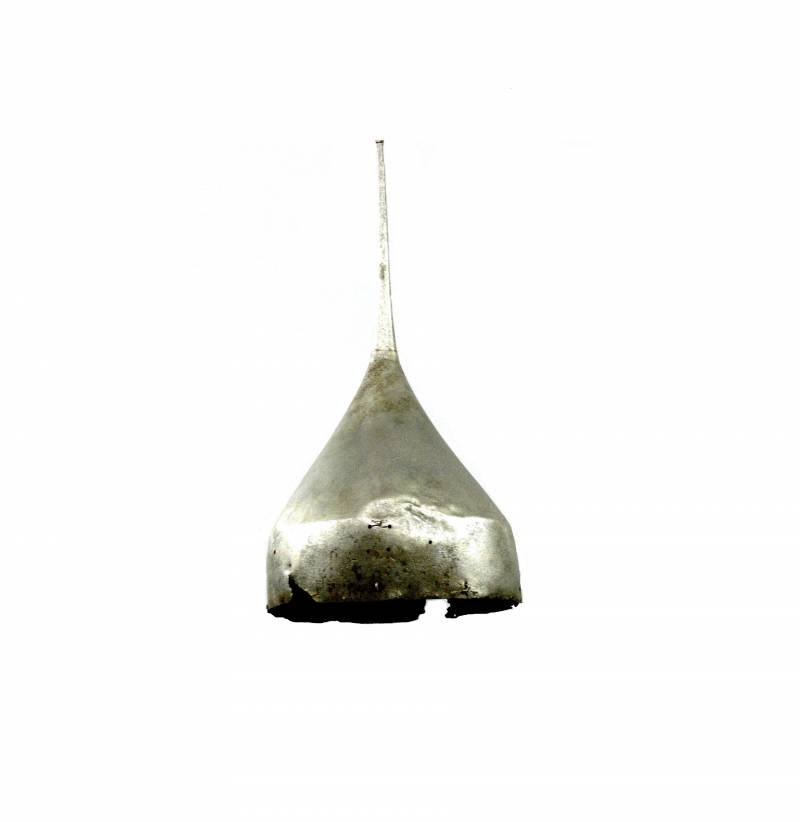
Russian helmet. XVII century Istanbul Army Museum. Türkiye. Photo by the author.
And King John II Casimir by this time was able to assemble a quartz (professional) army and a noble militia, the combat effectiveness of which, of course, was much higher than that of the Tatars and Cossacks, and even more so that of the “khlops” and burghers who joined.
After a series of victories by the Polish-Lithuanian troops, the situation for the rebels became desperate, many people fled to Russia and even to Crimea and Turkey. Since 1651, after military failures, the hetman understood that without Russian help the war would be lost.
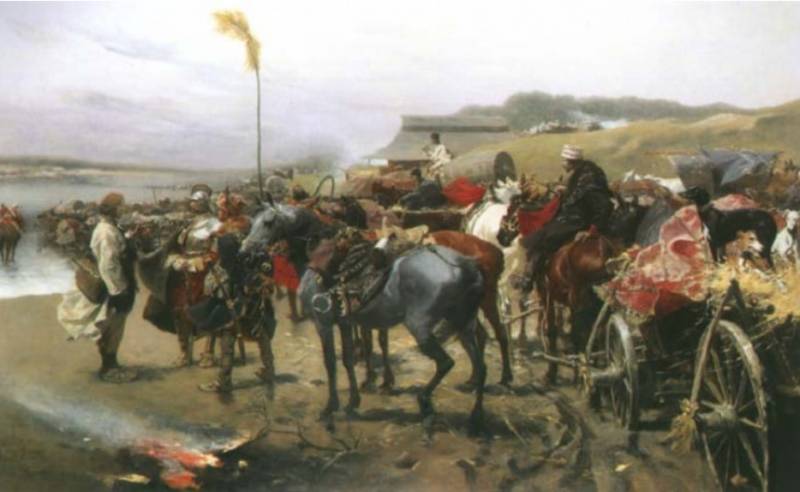
Polish-Lithuanian Commonwealth destruction. Hood. Yu. Brandt. XIX century
And in Moscow there was absolutely no desire to participate in the war with Poland. Russian ambassadors in 1653 were ready to make concessions to King John II Casimir if he would forgive the Cossacks and accept them into his service. In case of failure in negotiations with the Poles, there was another plan: the resettlement of willing rebels to the Don. In this way, Russia could strengthen its borders and avoid war with the Polish-Lithuanian Commonwealth.
But the logic of history went differently.
Khmelnytsky now saw his future as an independent head of Little Russia, Duke of Chigirinsky, under the nominal supremacy of an Orthodox tsar. And Tsar Alexei continued to doubt. That is why the Zemsky Sobor was assembled, which was supposed to reinforce the decision of the autocrat. A typical management situation.
And the noble delegates, the military class, supported the war; after all, feudal lords were created for war. At the same time, the Moscow monarch clearly understood that he was the head of all Orthodox Christians, and the war with the Polish Republic was a war for faith and Christian souls.
On January 8, 1654, the Pereyaslav Rada swore allegiance to the Moscow sovereign with all Ukraine,
after which “all regiments” (lands) and cities of Little Russia were sworn in to the Tsar.
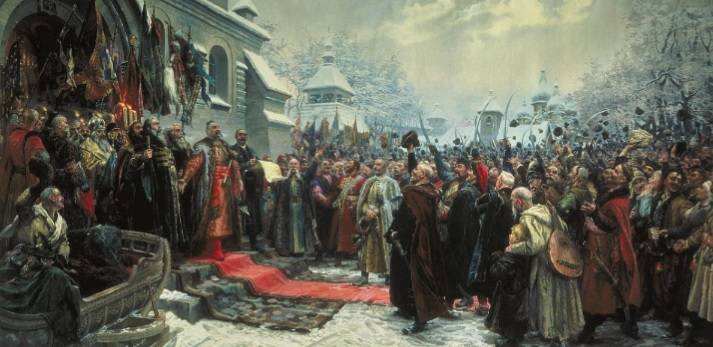
“Forever with Moscow, forever with the Russian people.” Artist M. I. Khmelko. 1951
Russes and Russians
The discussion about the ethnic difference or similarity between “Russians” and “Russians” continues in science. During this period, Ukraine and Little Russia were geographical, not ethnic, concepts. In the consciousness of society of that period, Russians in Ukraine were precisely Orthodox. Therefore, the punishing sword of the Cossacks destroyed, first of all, the Russian gentry who had become Polish.
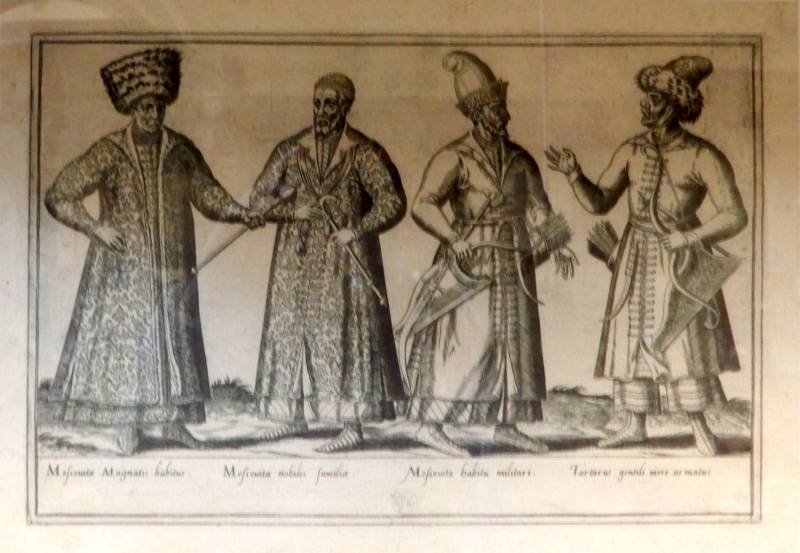
Muscovites of the XNUMXth century Engraving. GIM. Photo of the author.
Ethnic differences were, of course, present. They were predetermined not only by their geographical location, but also by the economic structure associated with it. The differences were not radical, but they still existed: for example, in clothing, housing and everyday life.
The Cossacks, for example, shaved their beards and heads in the steppe fashion, while in Russia everyone wore beards without exception. On the other hand, the Tatars, for example, did not see any difference between the Russians of the south and the north. In general, the process of ethnic self-identification was in its infancy, because the society was agrarian and feudal.
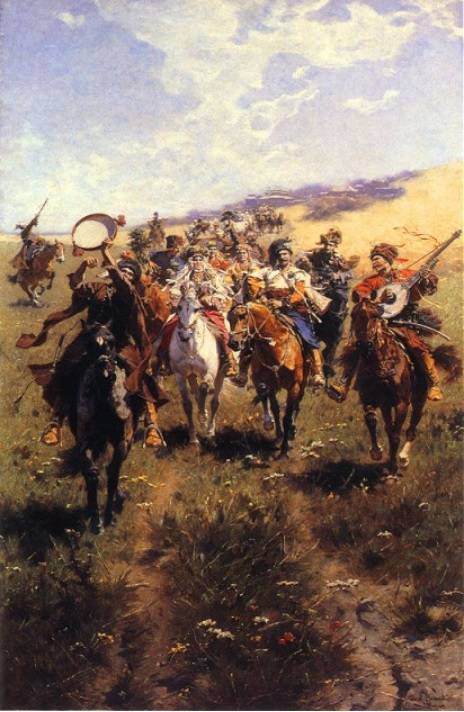
Cossack wedding. Hood. Yu. Brandt. XIX century
But what if there is no alternative?
Social differences were key. Feudalism for Russia at this time was natural, caused by the development of its society. For the southern and western lands of the former Ancient Rus', which is at the stage of decomposition of the territorial community,
feudalism became an external, colonizing form of exploitation by a more developed society.
All the talk about the “democracy” of the Cossacks and its opposition to the “despotism”, for example, of the Russian Tsar, stems precisely from this fact.
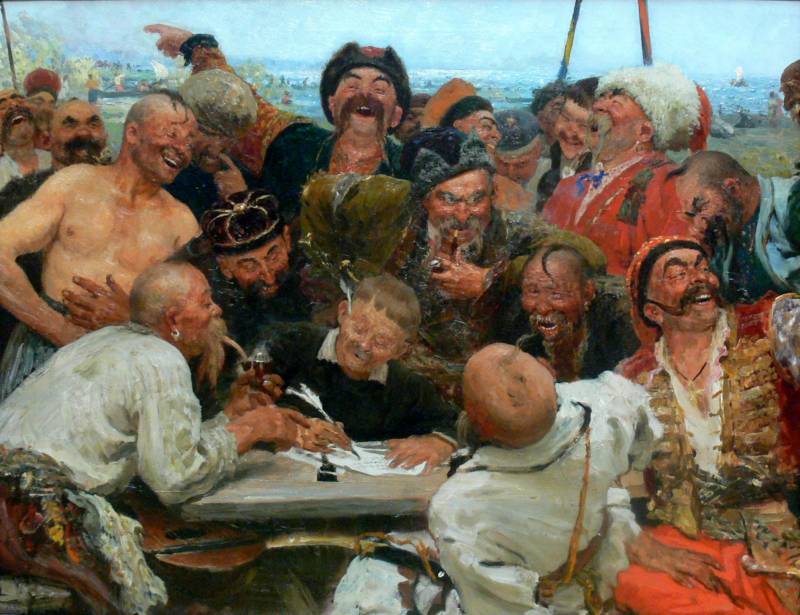
The Cossacks write a letter to the Turkish Sultan. Hood. I. Repin. Fragment. Photo by the author.
The dying form of management of the pre-class period had no future prospects. The path of Ukraine in this period can be compared with the path of Novgorod and Pskov in the XNUMXth century. Both here and there these were remnants of the territorial community society, the management system of “primitive democracy” with elements of oligarchy in the Zaporozhian Army and the “oligarchic republic” in Novgorod. As control systems they were unable to cope with external challenges, and this was precisely what was decisive during this period.
It is significant that both the Cossacks and the boyars of Novgorod tried to find a more acceptable sovereign for themselves.
Without Russian intervention, the Cossack movement would have been completely suppressed or completely destroyed by the Polish-Lithuanian Commonwealth. The gentry (feudal lords) saw the Cossacks exclusively as insolent “khlops” (men). Or the Russians of these lands would have fallen under Turkish rule with subsequent Islamization. How it happened when hetmans seeking personal gain temporarily fell under the heavy hand of the Sublime Porte in the second half of the XNUMXth century. And their co-religionists in the XNUMXth century: Albanians and part of the Serbs.
If tomorrow is a hike
The war between Russia and the Commonwealth began successfully, Smolensk, all of Belarus and Ukraine were liberated, even Vilna (Vilnius), that is, almost all the lands that were part of Ancient Rus', was occupied. At the initial stage, the Russian feudal army proved to be very good, justifying the huge costs of maintaining the noble militia, in contrast to the Polish "knights" from the commonwealth.
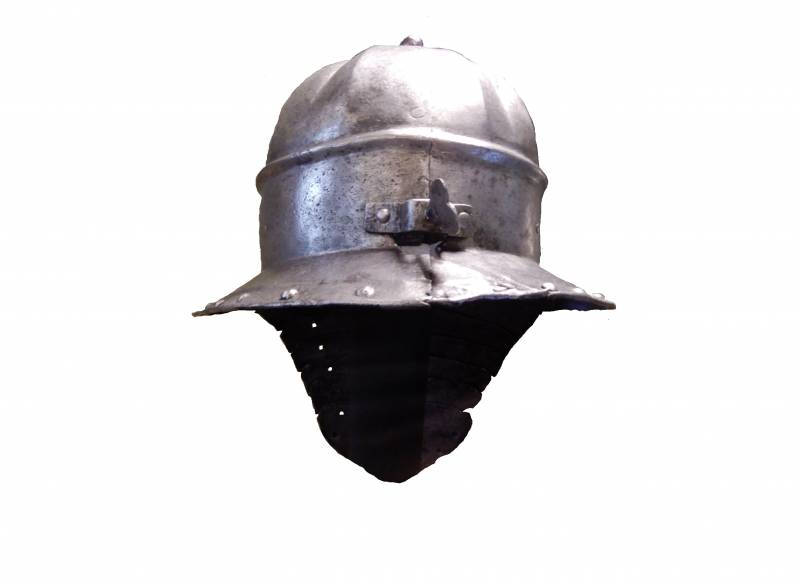
Hussar helmet "Capelin". Western Europe. End of the XNUMXth – beginning of the XNUMXth centuries. Steel; forging. State Historical Museum. Moscow. Photo by the author.
But, seeing the weakening of Poland, it was attacked in 1655 by the first-class military power of the north - Sweden. The “Swedish Flood” began for Poland. The Swedes, in alliance with Brandenburg, a recent vassal of Poland, Transylvania and Bogdan Khmelnitsky, seized its lands.
Under such conditions, the Lithuanian hetman J. Radziwill, whose lands had already been occupied by Russia, declared the Swedish king his sovereign. In 1656, the Russian army began a war in the Swedish Baltic, and the tsar himself laid siege to Riga. In Moscow, it seemed that the issue in Little Russia was already closed, and it was possible to switch to another front.
But it was not there. Because with the death of Khmelnitsky in 1657, fluctuations began in the ranks temporarily united Cossacks. The key reason for these fluctuations was the divergent interests of the upper and lower classes among the Cossacks, which we wrote about, the habit of freedom and anarchy of the Cossacks, which was impossible under the Moscow scepter.
Attempts to create the Grand Duchy of Russia as part of the Polish-Lithuanian Commonwealth, naturally, were rejected by the Polish Sejm. What kind of Grand Duchy could we be talking about when the gentry saw in Ukraine a servile or peasant “colony”, and not an equal part of the “republic”.
A tragic page in history began, which was called "The Ruin". The hetmans tried either to negotiate with Poland, or became subjects of Istanbul, like Yuri Khmelnitsky and Petro Doroshenko. They brought Turks and Tatars to the south of Ukraine. They turned churches and churches into mosques and carried out violent Islamization, and the sale of people into slavery took place right before the eyes of the hetman, in Chyhyryn.
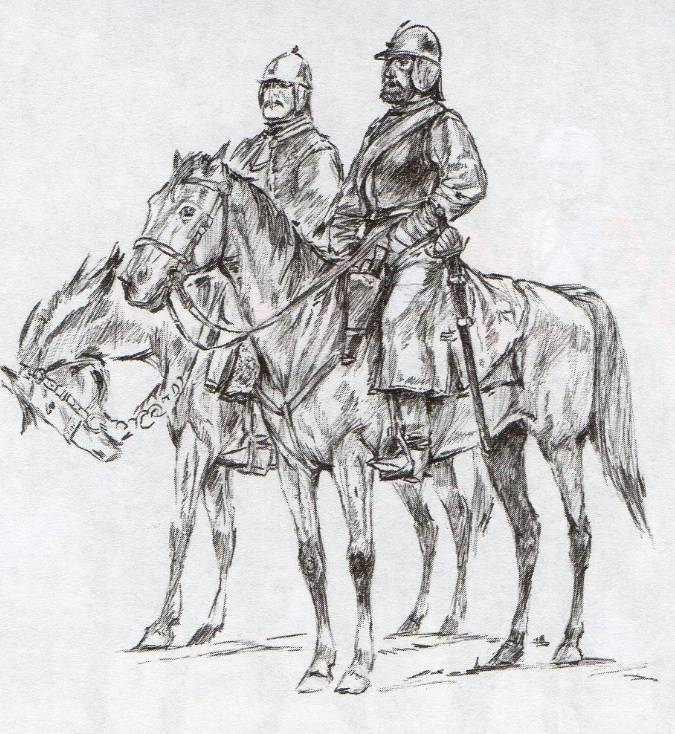
Russian reiters of the mid-XNUMXth century. Hood. V. Tipikin.
In 1658, Russia promptly signed first a truce, and then the Treaty of Cardis with Sweden in 1661, renouncing all conquests in the Baltic. But now Russia, weakened by the war with Sweden, waged a war with Poland rather sluggishly, however, like the latter.
In the end, in 1667, a truce was signed: Smolensk, Starodub and Chernigov, captured during the intervention, returned to Moscow, left-bank Ukraine and Kyiv withdrew, the latter for a period of only two years.
In anticipation of the military threat from Istanbul, Poland and Russia were forced to come to an agreement, which in an era of general superstition and mistrust excited the Cossacks, who were afraid that Russia would hand them over to Poland again.
It should be said that after the peace of 1661 in Sweden, the military party of Magnus Delagardie thirsted for revenge, so the uprising of Stepan Razin was seen as a situation similar to the Time of Troubles, when it was possible to significantly profit at the expense of Russia and resolve all controversial issues in its favor.
From 1677 to 1681, the Russian-Turkish War began, the struggle also took place around Kyiv, it went on with varying success, although the Turks were able to capture Chigirin. During this war, a third, Izyum defensive line against Crimean raids was built. And the Bakhchisarai truce of 1681 confirmed Russia’s right to Kyiv.
On the eve of the great war of European countries with Turkey, the Polish king John III Sobieski signed the “Eternal Peace” with Russia in 1686, which assigned Kiev to Russia for 1 Polish pounds and guaranteed the rights of Orthodox Christians in Poland. As part of the European coalition “Holy League,” Russia took part in the war against Turkey, making two fruitless campaigns in the Crimea, in 500 and 000. under the leadership of Prince. V.V. Golitsyna.
Thus, the feudal military system was able to permanently defend the country's borders. The young noble, feudal state, straining all its strength, was able to successfully emerge from all the wars of the XNUMXth century.
When the feudal warrior class was finally formed in Russia, in the 30s and 40s. XVII century, the “great firearms revolution” was ending in Europe, and the emerging early bourgeois systems of European countries began to pose challenges to other countries, threatening their existence. The question of reducing the gap in technology has arisen before Russia in full force.
To be continued ...
Information